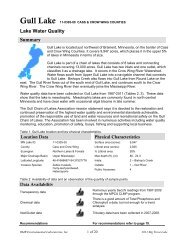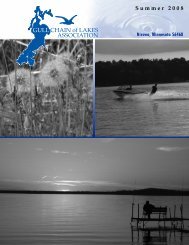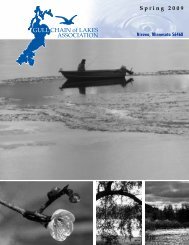Summer - Gull Chain of Lakes Association
Summer - Gull Chain of Lakes Association
Summer - Gull Chain of Lakes Association
You also want an ePaper? Increase the reach of your titles
YUMPU automatically turns print PDFs into web optimized ePapers that Google loves.
Q&A ABOUT THE WATERCRAFT AND BAIT CONTAINER DRAINING LAWS IN MINNESOTA<br />
Revised June 9, 2011 • Reprinted From Minnesota DNR Website<br />
Q. What does the 2011 version <strong>of</strong> the “Drain Plug” law require?<br />
A. The 2010 Minnesota Legislature passed a new boat draining law that took effect on July 1, 2010. This law<br />
was created to reduce the risk <strong>of</strong> boaters spreading fish diseases (e.g., VHS) and life stages <strong>of</strong> aquatic invasive<br />
species (e.g., spiny waterfleas and zebra mussel larvae) that are not easily observed or detectable in<br />
water and could be transported to other waters. Often new infestations are not detected immediately, so there<br />
are risks <strong>of</strong> transporting water from all waters including from those in other states. In 2011, the law was modified<br />
(Minnesota Statutes. 84D.10, Subd. 4) and as <strong>of</strong> May 28, 2011 it currently states,<br />
(a) When leaving waters <strong>of</strong> the state a person must drain water-related equipment holding water and live wells and<br />
bilges by removing the drain plug before transporting the water-related equipment <strong>of</strong>f the water access site or riparian<br />
property.<br />
(b) Drain plugs, bailers, valves, or other devices used to control the draining <strong>of</strong> water from ballast tanks, bilges, and live<br />
wells must be removed or opened while transporting water-related equipment.<br />
(c) Emergency response vehicles and equipment may be transported on a public road with the drain plug or other similar<br />
device replaced only after all water has been drained from the equipment upon leaving the water body.<br />
(d) Portable bait containers used by licensed aquatic farms and marine sanitary systems are exempt from this subdivision.<br />
(e) A person must not dispose <strong>of</strong> bait in waters <strong>of</strong> the state.<br />
Q. What do people need to do with bait containers?<br />
A. The law requires all water to be drained from portable bait containers before leaving the water access<br />
including from bait containers that have not been placed in lake or river water.<br />
Q. How can I comply with draining portable bait containers when portaging from one lake to another?<br />
A. If you are portaging a canoe or other watercraft, you will need to drain the water from the bait container<br />
on land where it won’t drain into any water body and refill the bait container with water from the new water<br />
body.<br />
Q. After draining water from bait containers can I keep unused bait?<br />
A. Anglers can keep unused bait after draining their bait containers. You can replace the water in portable<br />
bait containers with tap or bottled water before transporting the bait. Some angling related businesses have<br />
developed products to help transfer bait from a bait container in the boat to a container in a motor vehicle<br />
without the water.<br />
Q. How do people need to dispose <strong>of</strong> unused, unwanted bait?<br />
A. As <strong>of</strong> July 1, 2010, state law prohibits dumping unused bait into waters <strong>of</strong> the state. Dumping bait on the<br />
ground is considered littering. Therefore, unwanted live bait should be placed in the trash, disposal bins, or<br />
compost bins where you are allowed to place such material.<br />
16















